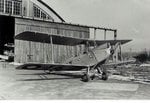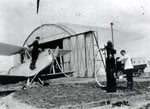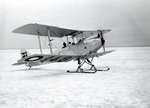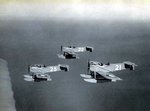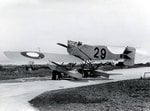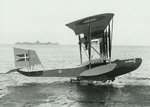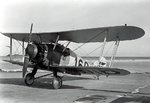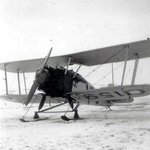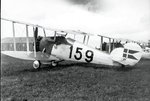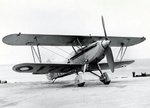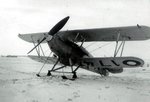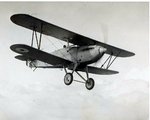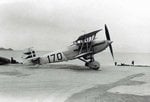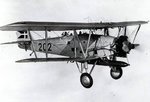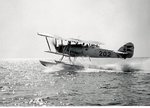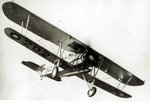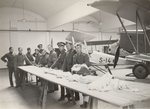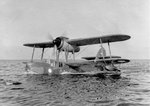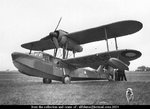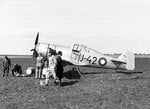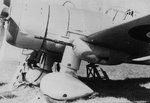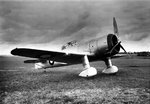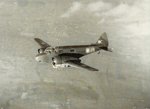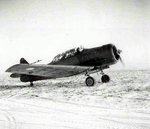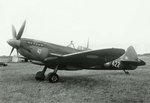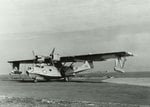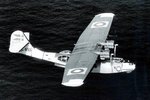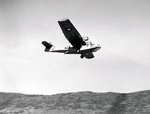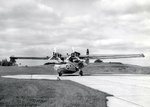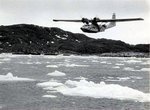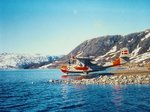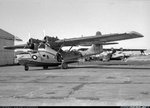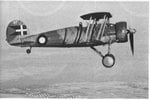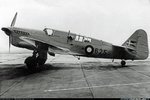Before the outbreak of the war, Denmark was extremely unprepared having downgraded its military force. The air defence was divided into the Naval Air Service and the Army Flying Corps. The Naval Air Service had a squadron of outdated Hawker Nimrod (Danish version of Fury) fighters and seaplanes. Some were for use in Greenland and there was a growing interest in torpedo launching. The Army Flying Corps had Gloster Gauntlets fighters and was upgrading to Fokker D XXI fighters The first was bought in Holland the rest were built in Denmark. A Danish production of Fairey Battle bombers had started but none were finished. Licence to build the Fokker G-1 heavy fighter was acquired.
On the morning of April 9th 1940 the German occupation started finding Denmark as unprepared as many other countries. An attack by a stafel of ME-110 fighters destroyed most planes at the Vaerloese Army Airfield. One Danish aircraft was shot down during take off. From that day Danish military aviation stopped. Aircrafts were kept in storage. Some were taken by the German occupation force and reused elsewhere. The majority of the aircrafts were destroyed at a later stage by the Danish resistance. Two incidents may be noted as they formed the background for Ken Folletts novel: Hornet flight. In 1941 two lieutenants managed the refurbish a deHavilland Hornet Moth and to take off for a flight to Britain where one joined to RAF the other served in a special capacity due to his knowledge of German radar systems. In the fall of 1943 another Danish pilot under the same difficult circumstances took off in a deHavilland Moth to fly to England. He joined Special Intelligence Service.
A great number of Danes joined allied forces. Some of these as airmen. Quite a few come to RAF via the Norwegian training camp built up in Canada. After the training The Norwegians formed their own squadrons in RAF. Others joined became operational through other channels. Danes were flying in the RAF, in the Norwegian RAF squadrons, in the Royal Canadian Air Force and in the South African Air Force. Danes served as pilots and in other capacities in RAF. One example is Morian Hansen predicted winner of the 1939 speedway world championship that was never held. He was too old to be a pilot and won a DSO as a tail gunner. A Danish born woman served as one of the ferry pilots. Danes living in Britain collected money and donated three spitfires to RAF. Sadly two of them only lasted a fortnight before they were shot down. Of the Danish pilots 26 were killed in action. The size of the Danish involvement was, however, limited compared with other nations. Danish opposition to Nazi Germany was inside Denmark and in the merchant navy.
Danes escaping to Sweden also included military personnel. A Danish Brigade was formed very discretely due to Swedish neutrality. This brigade also had a Danish flying squadron. It was flying as a part of the Swedish air force. The squadron was nominated to 15 SAAB B-17 dive bombers intended for ground support for the brigade when it should participate in the recapture of Denmark. The German forces surrendered on May 5th 1945 and the fighting following was relatively light. The brigade did not use the air support. The squadron was flying in Swedish colours until May 5th when all planes were painted in Danish colours.
Danish Air Force Photo Page
On the morning of April 9th 1940 the German occupation started finding Denmark as unprepared as many other countries. An attack by a stafel of ME-110 fighters destroyed most planes at the Vaerloese Army Airfield. One Danish aircraft was shot down during take off. From that day Danish military aviation stopped. Aircrafts were kept in storage. Some were taken by the German occupation force and reused elsewhere. The majority of the aircrafts were destroyed at a later stage by the Danish resistance. Two incidents may be noted as they formed the background for Ken Folletts novel: Hornet flight. In 1941 two lieutenants managed the refurbish a deHavilland Hornet Moth and to take off for a flight to Britain where one joined to RAF the other served in a special capacity due to his knowledge of German radar systems. In the fall of 1943 another Danish pilot under the same difficult circumstances took off in a deHavilland Moth to fly to England. He joined Special Intelligence Service.
A great number of Danes joined allied forces. Some of these as airmen. Quite a few come to RAF via the Norwegian training camp built up in Canada. After the training The Norwegians formed their own squadrons in RAF. Others joined became operational through other channels. Danes were flying in the RAF, in the Norwegian RAF squadrons, in the Royal Canadian Air Force and in the South African Air Force. Danes served as pilots and in other capacities in RAF. One example is Morian Hansen predicted winner of the 1939 speedway world championship that was never held. He was too old to be a pilot and won a DSO as a tail gunner. A Danish born woman served as one of the ferry pilots. Danes living in Britain collected money and donated three spitfires to RAF. Sadly two of them only lasted a fortnight before they were shot down. Of the Danish pilots 26 were killed in action. The size of the Danish involvement was, however, limited compared with other nations. Danish opposition to Nazi Germany was inside Denmark and in the merchant navy.
Danes escaping to Sweden also included military personnel. A Danish Brigade was formed very discretely due to Swedish neutrality. This brigade also had a Danish flying squadron. It was flying as a part of the Swedish air force. The squadron was nominated to 15 SAAB B-17 dive bombers intended for ground support for the brigade when it should participate in the recapture of Denmark. The German forces surrendered on May 5th 1945 and the fighting following was relatively light. The brigade did not use the air support. The squadron was flying in Swedish colours until May 5th when all planes were painted in Danish colours.
Danish Air Force Photo Page


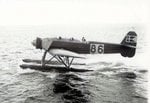
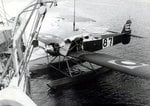
 ) and 56kW Armstrong Siddeley Genet (as the Genet Moth).
) and 56kW Armstrong Siddeley Genet (as the Genet Moth).
